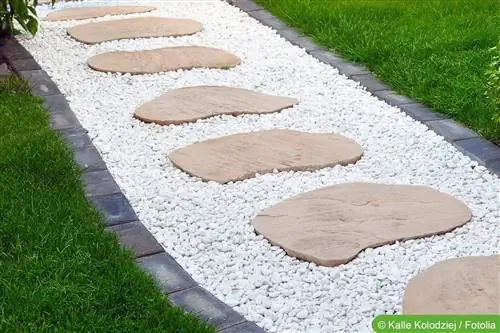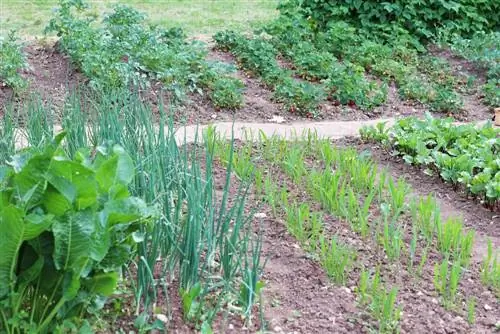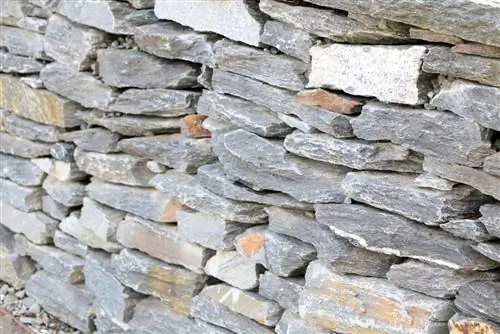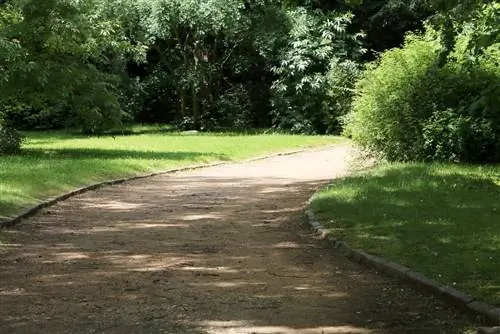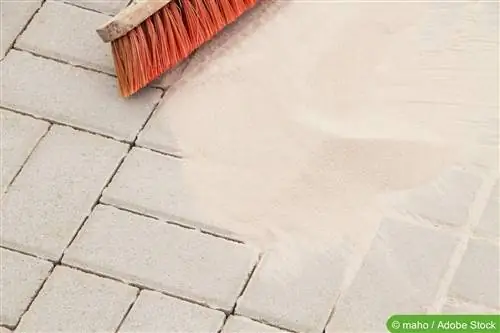- Author admin [email protected].
- Public 2023-12-17 03:39.
- Last modified 2025-01-24 12:45.
For garden paths with normal loads, no edge fastening is usually required. It looks nicer here when the path leads directly into the garden. Of course, you can also create an edge attachment to visually separate the path and garden.
Are you creating a garden path or a driveway?
Correct planning of a garden path also includes considering what loads this garden path should withstand. As part of these considerations, you will usually come to the realization that you are actually in the process of creating various garden paths:
- If there is a piece of garden path in front of the house that can also be used by a vehicle, a garage entrance or a courtyard entrance, for example. E.g., this might also be a “garden path” for you, but it has to withstand considerable loads.
- If you want to equip the terrace with the same surface as the garden path leading from it, and there is a slope after the terrace, that is also a special case.
- You definitely need edge fastening for such sections or areas.
- The main path through the garden is also mostly used, although only by a wheelbarrow, but when fully loaded with earth it can become quite heavy.
- If you want to keep the garden path that you want to drive on with the wheelbarrow as narrow as possible, we recommend fixing the edge so that you don't end up driving the edge of the path crooked and crooked with the wheelbarrow.
- If the garden path leads through flat terrain in a certain area, is not subject to heavy loads and the soil allows rainwater to seep away quickly, you do not need a concrete edge reinforcement.
- You then have the choice: you can just extend the substructure a little over the edge of the path so that the path cannot tip over to the side, or you can stabilize the side edges with some concrete.
- Another variant, which is also conceivable for paths with surfaces with gravel or wood chips, is the introduction of a series of visually highlighted curbs.
Edging options for the garden path
- Edging with concrete mortar and handwork: A little mortar is filled between the side stones or you lay the edge stones or the first row of paving in a real bed of mortar.
- The next option is to provide the side edges with a concrete back support. They create a kind of sloping concrete boundary that starts under the stones and ends in the middle of the side.
- Such a back support will hold even better if you also place the first row in a concrete bed.
- When it comes to heavily loaded paths or areas, you should concrete a series of special edging stones on the sides (not to be confused with the only slightly stabilizing curbs for the lightly loaded garden path).
When necessary?
Edge reinforcement is only necessary on heavily used paths or driveways. Then you should consider concrete edge reinforcement. If you want to be on the safe side, you can also surround the curbs of the paved floor in concrete, but this is not absolutely necessary.
Whether edge fastening is an option also depends on the time and money spent. With around 25-30 liters of concrete per meter, this fun can be expensive with large driveways and paths. This work also requires a lot of time and patience.
If you plan such work, you should do it in spring or autumn if possible, as the temperatures are most pleasant at these times of the year.
Conclusion
Not necessary for the garden path and simple drive-ins. However, special cases such as a garden with a lot of slope or steps should be taken into account. If you lay steps in the garden with slabs, you should prefer edge fastening or even embedding them in concrete, as these slabs are particularly stressed.
The next part will also be about stairs and steps, because they require a lot of attention. This shows that setting in concrete is important.

